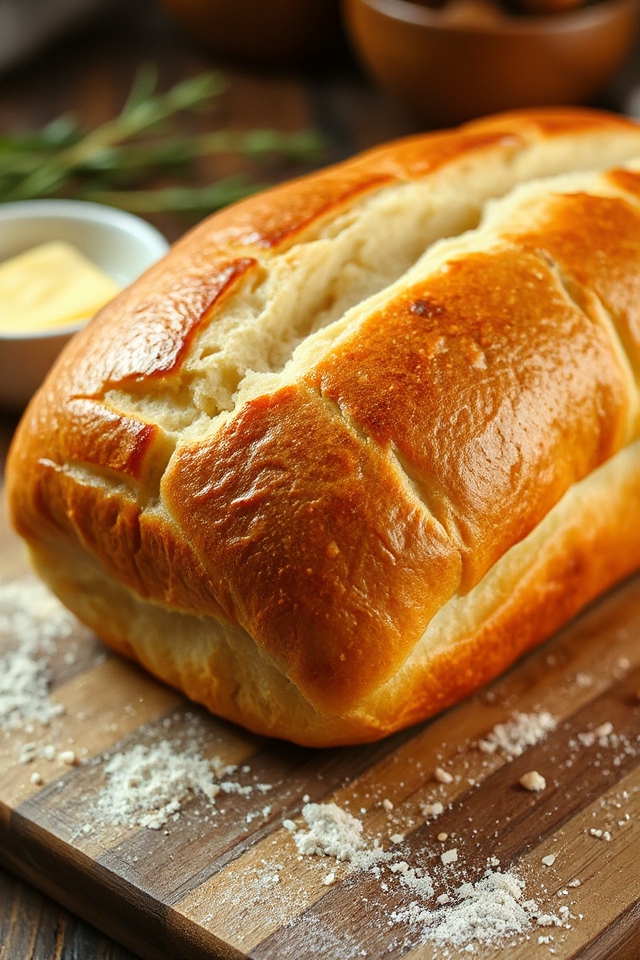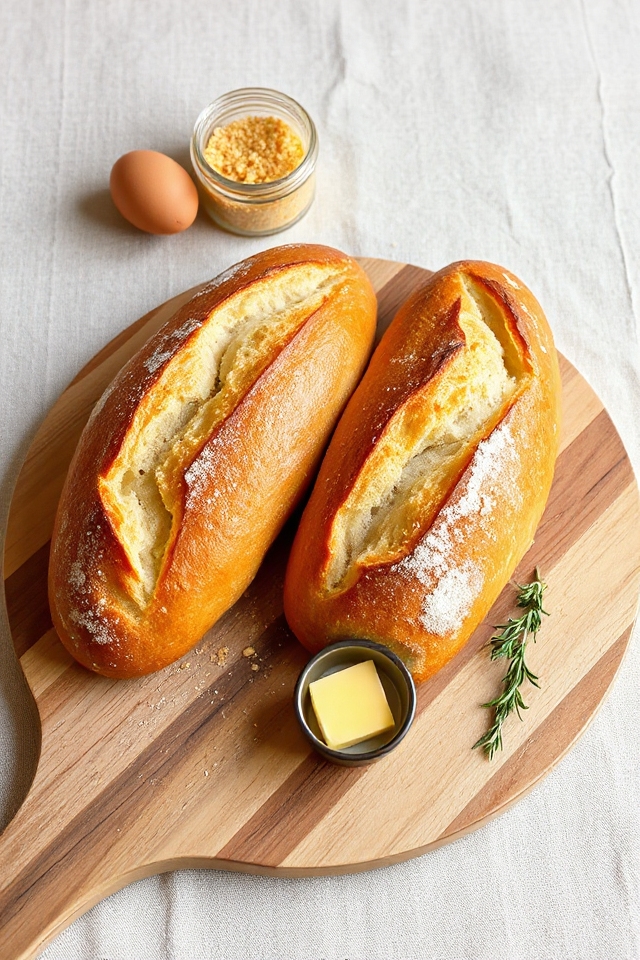Why You’ll Love This Gluten Free French Bread Recipe
You’re going to love this gluten-free French bread recipe for its incredible texture and flavor.
I’ve made it countless times, and each loaf turns out beautifully airy and crusty. The aroma that fills my kitchen while it bakes is simply irresistible!
I appreciate how it’s perfect for sandwiches or just enjoying with a little butter. Plus, it’s surprisingly easy to make; I can whip it up even on busy days.
Every bite reminds me of traditional French bread, and I can’t help but smile knowing I can indulge without worrying about gluten.
Trust me, you’ll want to try this!
Ingredients of Gluten Free French Bread
When it comes to baking gluten-free bread, the right ingredients can make all the difference. For this gluten-free French bread recipe, you’ll need a mix of flours, some essential binders, and a few other tasty additions. Don’t worry if you’re new to gluten-free baking; the ingredients are straightforward and easy to find.
Plus, once you gather everything, you’ll be well on your way to creating a delicious loaf that’ll make your kitchen smell heavenly. Trust me, it’s worth the little bit of prep!
Here’s what you’ll need to whip up your gluten-free French bread:
- 2 cups rice flour (white)
- 1 cup tapioca flour
- 3 teaspoons xanthan gum
- 1 ½ teaspoons salt
- 2 teaspoons egg substitute (if desired)
- 2 tablespoons sugar
- 1 ½ cups lukewarm water
- 2 tablespoons fast rise yeast
- 2 tablespoons butter or margarine, melted
- 3 egg whites, beaten slightly
- 1 teaspoon vinegar
- Melted butter for brushing (optional)
Now, let’s chat about some of these ingredients. Rice flour is like the superstar of gluten-free baking; it gives the bread a lovely texture.
Tapioca flour adds a bit of chewiness, kind of like that satisfying crust on a traditional loaf. Xanthan gum? It’s a magical binder that helps hold everything together, which is key when gluten is absent.
If you’re vegan or just out of eggs, the egg substitute works great, but I promise you won’t miss the eggs either way. And let’s not forget the yeast, which is what brings our dough to life and gives it that airy quality we all love in bread.
How to Make Gluten Free French Bread

Making gluten-free French bread might sound intimidating, but trust me, it’s really not as scary as it seems. First things first, you’re going to want to grab your heavy-duty mixer because we’re about to get mixing. In the bowl, combine 2 cups of rice flour, 1 cup of tapioca flour, 3 teaspoons of xanthan gum, and 1 ½ teaspoons of salt. Give it a gentle blend on low. This is where the magic starts, combining those dry ingredients into a lovely little powdery mix that will form the base of your bread.
While that’s happening, let’s tackle the yeast. In a small bowl, dissolve 2 tablespoons of sugar in 1 ½ cups of lukewarm water, and then sprinkle in 2 tablespoons of fast rise yeast. Honestly, watching the yeast foam up is one of the more satisfying moments in the kitchen, like a little science experiment.
Once it’s all frothy and bubbly, pour that yeast mixture into your dry ingredients. Now, toss in 2 tablespoons of melted butter (or margarine if that’s your jam), 3 slightly beaten egg whites, and 1 teaspoon of vinegar. Time to crank that mixer up to high and let it beat away for 3 minutes. This is where your dough starts coming to life, and oh, it smells delightful.
Now, the fun part—shaping the dough. It’s going to be a bit sticky, and that’s totally normal. Spoon it onto greased and cornmeal-dusted cookie sheets, forming two long French-loaf shapes. If you’re feeling fancy, you can use special French-bread pans; but hey, cookie sheets work just fine.
Don’t forget to make those diagonal slashes on top, which not only look pretty but also help the bread bake evenly. Once that’s done, cover the dough and let it rise in a warm spot for about 20 to 25 minutes until it doubles in size. Preheat your oven to 400 degrees while you wait.
Once it’s risen, pop it in the oven for 40 to 45 minutes. You’ll want to let it cool a bit once it’s out because, honestly, burning your fingers on hot bread isn’t a good look. Enjoy the heavenly aroma wafting through your kitchen as you anticipate that first slice of warm, gluten-free goodness.
Gluten Free French Bread Substitutions & Variations
While gluten-free French bread is delicious as is, experimenting with substitutions and variations can elevate your baking experience.
I love swapping rice flour for almond or chickpea flour for a nuttier flavor. You can also replace tapioca flour with potato starch for a different texture.
If you’re looking for a dairy-free option, coconut oil works well instead of butter. For added taste, try mixing in herbs like rosemary or thyme.
To make it a bit sweeter, add honey or maple syrup instead of sugar. Adjusting the ingredients lets you customize the bread to suit your personal preferences!
Additional Tips & Notes
Experimenting with substitutions can enhance your gluten-free French bread, but there are also some additional tips that can make the baking process smoother and the results even better.
First, verify your ingredients are at room temperature; this helps the dough rise properly.
When mixing, don’t rush—give it a good three minutes on high to develop the texture you want.
Also, consider using a kitchen thermometer to check your water’s temperature; it should be lukewarm, around 110°F.
Finally, let the bread cool completely before slicing to maintain its structure.
Happy baking!
